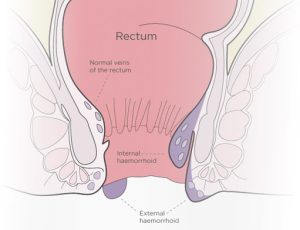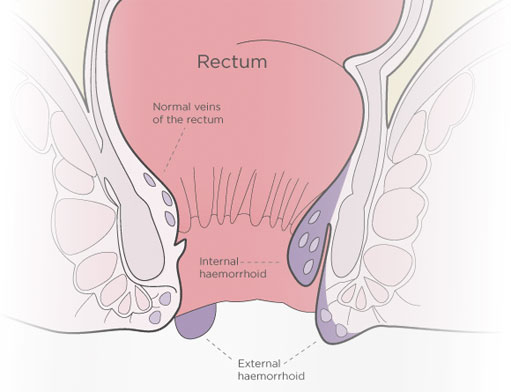Haemorrhoids / Hemorrhoids
Haemorrhoids also called piles, are swollen veins in the anus and lower rectum, similar to varicose veins due to poor local circulation. First degree haemorrhoids, remain inside the rectum, but may bleed. Second degree haemorrhoids, bleed and protrude beyond the anus but return after defecation. Third degree haemorrhoids, remain outside the anus and have to be pushed back manually.

Causes of Haemorrhoids
Some causes of haemorrhoids include constipation, sluggish liver, grumbling appendix, pregnancy, etc. The underlying cause must be treated.
Herbal Remedies for Haemorrhoids
There are a number of herbs traditionally employed in the treatment of haemorrhoids.
Michael Moore’s recommendations
Pilewort and Stone root are key remedies.
Alternatives: Teas from any of the following herbs: Butcher’s Broom, Balmony, Bilberry, Beth root, Bistort, Cranesbill, Figwort, Ground Ivy, Horsechestnut, Ladies Mantle, Nettles, Oak bark, Pilewort, Plantain, Silverweed, Stone root, Tormentil, Wild Yam, Witch Hazel.
Alternative formulae
Tea:
(1) Equal parts, Yarrow, Witch Hazel leaves, German Chamomile.
(2) Equal parts, Yarrow, Pilewort, Mullein.
(3) Equal parts, Plantain, Figwort, Pilewort.
1-2 teaspoons to each cup of boiling water; infuse 15 minutes. 1/2 to 1 cup three times daily before meals.
Tablets/capsules: Take capsules with any of these: Pilewort, Cranesbill, Wild Yam, Blue Flag root.
Powders/Formula: Pilewort (1 part); Figwort (1 part); Stone root (half part). Dose: 500mg (two 00 capsules or one-third teaspoon) three times daily.
Tinctures – Formula Butternut (1 part); Figwort (1 part); Cascara (1/4 part). One 5ml teaspoon in water three times daily. Alternative: Combine Hawthorn (2 parts); Stone root (1 part). Dose: 30-60 drops in water three times daily.
Enema: Strong infusion of Raspberry leaves: 2oz to 2 pints boiling water. Steep for 20 minutes and strain. Improves with addition of 5 drops Tincture Myrrh.
Suppositories: 1 part Liquid Extract Witch Hazel or German Chamomile to 5 parts Cocoa butter.
Ointments: Pilewort, Chickweed, Figwort, Horse Chestnut, Houseleek.
Psyllium seeds increases bulk of the stools making them softer and easier to pass.
To alleviate itching and assist healing: insert into the anus fresh peeled Houseleek.
Vitamin E capsules. Piles that had resisted all other forms of treatment rapidly cleared. Insert one capsule into rectum night and morning.
Supportives: Sitz bath. Sponge anus with cold water.
Poultices
Elder leaves: Apply poultices of leaves of Elder over the Haemorrhoids.
Mullein leaves: The leaves can also be used as poultices applied locally to haemorrhoids.
Prickly Poppy seeds: The seeds may be pounded and used as a poultice for haemorrhoids.
Starwort, Chickweeds: A poultice of the plant has been used to treat hemorrhoids.
Shepherd’s Purse: Used as a decoction to treat haemorrhoids.
Blackberry leaves: The leaves, bruised and applied outwardly, will act as an astringent to haemorrhoids.
Dr Sebi’s Eva Salve
Dr Sebi’s Eva Salve is known to be effective for haemorrhoids. It contains Shea Butter, Nopal, Lily of the Valley, Olive Oil, Arnica, Sage, Eucalyptus and Manzo.
Dr Weiss’s Recommendation
Dr. Weiss favoured Arnica spp. (arnica) compresses, which he considered one of the fastest remedies for acute hemorrhoid inflammation. He recommended using 1– 2 tsp (5- 10 ml) of arnica tincture per 1 ⁄ 2 l ( 1 ⁄ 2 quart) of water for compresses. Alternatively, he recommended the use of an Quercus spp. (oak) bark decoction or a Matricaria recutita (chamomile) infusion. He typically followed the application of compresses with a witch hazel ointment. (Eric Yarnell etal.)
Diet
Diet: Diet should primarily consists of fruits, green juices, and light salads (Low salt, low fat, high fibre).
Supplements: Seamoss/Bladderwrack/Nettle.
 Loading...
Loading...
Reference(s)
Bartram’s Encyclopedia of Herbal Medicine (1995), Thomas Bartram
Petersen’s Materia Medica (1905), F.J. Petersen M.D.
Clinical Botanical Medicine. Eric Yarnell, N.D., R.H., Kathy Abascal, B.S., J.D., Robert Rountree, M.D.
This article is copyrighted by Ital is Vital, 2025. Want to re-post this article? Visit our guidelines.
DISCLAIMER: THIS WEBSITE DOES NOT PROVIDE MEDICAL ADVICE
The information, including but not limited to, text, graphics, images and other material contained on this website are for informational purposes only. The purpose of this website is to promote broad consumer understanding and knowledge of various health topics. It is not intended to be a substitute for professional medical advice, diagnosis or treatment. Always seek the advice of your physician or other qualified health care provider with any questions you may have regarding a medical condition or treatment and before undertaking a new health care regimen, and never disregard professional medical advice or delay in seeking it because of something you have read on this website.
